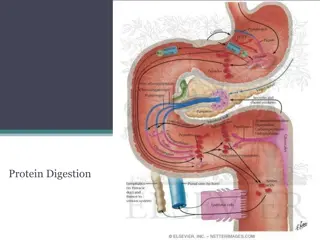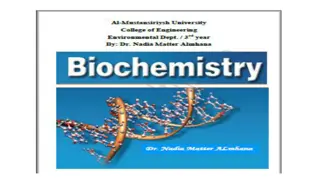Amino Acid Metabolism Pathways: Transamination, Deamination, and Clinical Significance of Transaminases
Amino acid metabolism involves pathways such as transamination, deamination, and the clinical significance of serum transaminases like ALT and AST. Transamination involves the transfer of amino groups, while deamination involves the removal of the amino group. Transaminases are important intracellular enzymes with levels indicating organ damage. Liver diseases, heart diseases, and skeletal muscle diseases impact serum transaminase levels differently.
Download Presentation

Please find below an Image/Link to download the presentation.
The content on the website is provided AS IS for your information and personal use only. It may not be sold, licensed, or shared on other websites without obtaining consent from the author.If you encounter any issues during the download, it is possible that the publisher has removed the file from their server.
You are allowed to download the files provided on this website for personal or commercial use, subject to the condition that they are used lawfully. All files are the property of their respective owners.
The content on the website is provided AS IS for your information and personal use only. It may not be sold, licensed, or shared on other websites without obtaining consent from the author.
E N D
Presentation Transcript
Dissimilation of Amino Acid (N-Catabolisim of Amino Acid) *transamination *Deamination(oxidative or nonoxidative deamination) *Transdeamination * NH3 transport *formation of urea.
Transamination *Transamination means transfer of amino group from -amino acid to -keto acid with formation of a new -amino acid and a new -keto acid. *The liver is the main site for transamination. *All amino acids can be transaminated except lysine, threonine, proline and hydroxy proline. *All transamination reactions are reversible. *It is catalyzed by transaminases. It needs pyridoxal phosphate as a coenzyme.
Role of pyridoxal phosphate in transamination Pyridoxal phosphate acts as an intermediate carrier for amino group. Pyridoxal phosphate accepts the amino group from amino acid to form. pyridoxamine phosphate, which in turn gives the amino group to a-keto acid. Examples of transaminases Alanine transaminase Aspartate transaminase Glutamate transaminase
Clinical significance of serum transaminases Transaminases are intracellular enzymes. Their levels in blood plasma are low under normal conditions. ALT (GPT) is present mainly in the cytoplasm of liver cells. AST (GOT) is present in both cytoplasm and mitochondria in liver, heart and skeletal muscles. -Any damage to these organs will increase the level of transaminases in blood
-In liver diseases, there is an increase in both serum ALT (SGPT) and AST (SGOT) levels. In acute liver diseases, e.g. acute viral hepatitis, the increase is more in SGPT -In chronic liver diseases, e.g. liver cirrhosis the increase is more in SGOT. -In heart diseases, e.g. myocardial infarction, there is an increase in SGOT only. -In skeletal muscle diseases, e.g. myasthenia gravis, there is an increase in SGOT only.
Deamination Deamination means the removal of amino group from a-amino acid in the form of ammonia with formation of a-keto acid The liver and kidney are the main sites for deamination Deamination may be oxidative or non oxidative
B-Non-oxidative deamination It is catalyzed by one of the following enzymes: 1-Dehydrases This enzyme deaminates amino acids containing hydroxyl group e.g. serine, homoserine and threonine.It needs pyridoxal phosphate as coenzyme.
2-Desulfhydrases This enzyme deaminates sulpher containing amino acids e.g. cysteine and cystine. It needs pyridoxal phosphate as a coenzyme.
Transdeamination (Deamination of L-Glutamic Acid) transdeamination, that is transamination followed by oxidative deamination. Transamination takes place in the cytoplasm of all the cells of the body; the amino group is transported to liver as glutamic acid, which is finally oxidatively deaminated in the mitochondria of hepatocytes. The enzyme L-glutamate dehydrogenase catalyzes the deamination of L-glutamate to forms NH3 and -keto glutarate.
First Line of Defense (Trapping of Ammonia) ammonia should be eliminated or detoxified. Even very minute quantity of ammonia may produce toxicity in central nervous system. ammonia is always produced by almost all cells, including neurons. The intracellular ammonia is immediately trapped by glutamic acid to form glutamine, especially in brain cells. glutamine is then transported to liver.
Transportation of Ammonia Inside the cells of almost all tissues, the transamination of amino acids produce glutamic acid. However, glutamate dehydrogenase is available only in the liver. Therefore, the final deamination and production of ammonia is taking place in the liver. Thus, glutamic acid acts as the link between amino groups of amino acids and ammonia.
Final Disposal The ammonia from all over the body thus reaches liver. It is then detoxified to urea by liver cells, and then excreted through kidneys. Urea is the end product of protein metabolism.
Why NH3 is toxic? Increased NH3 concentration enhances amination of - ketoglutarate, an intermediate in TCA cycle to form glutamate in brain. This reduces mitochondrial pool of - ketoglutarate consequently depressing the TCA cycle, affecting the cellular respiration. Increased NH3 concentration enhances "glutamine" formation from glutamate and thus reduces" brain-cell" pool of Glutamic acid. Hence there is decreased formation of inhibitory neurotransmitter "GABA"( - amino butyric acid)
Rise in brain glutamine level enhances the outflow of glutamine from brain cells. Glutamine is carried "out" by the same "transporter" which allows the entry of "tryptophan" into brain cells. Hence "tryptophan" concentration in brain cells increases which leads to abnormal increases in synthesis of " serotonin", a neurotransmitter.
Hyperammonaemia Two type: 1- Acquired hyperammonaemia: the result of Cirrhosis of the liver. 2-Inherited hyperammonaemia: results from genetic defects in the urea cycle enzyme .
Features of NH3 intoxication: The symptoms of NH3 intoxication include: - a peculiar flapping tremor - slurring of speech - blurring of vision - and in severe cases follows to coma and death. These resemble those of syndrome of hepatic coma, where blood and brain NH3 levels are elevated























